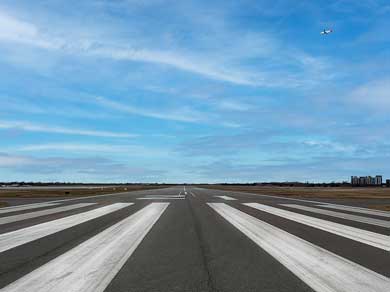Your last flight probably originated or connected through a commercial service hub—those huge airports like DFW, Atlanta, and Chicago that host a concentration of airline operations around the globe. But just below this well-known web of aviation infrastructure lies a network of airports that are just as important even though they are not widely known.
Both large and small airports maintain key facilities and fund their improvements through the Federal Aviation Administration Airport Improvement Program or state-specific funding opportunities such as Texas grants via TxDOT Aviation. Historically, though, funding has skewed in favor of those larger airports, says Peter Van Pelt, National Aviation Director for Pape-Dawson/KSA, a new member of the Pape-Dawson family with a strength in aviation planning. “About 80% of the almost-$4 billion from the Airport Improvement Program annually goes to 20% of the airports, based upon capacity and overwhelming need. That means the smaller airports usually must compete for funding to update their facilities.”
Those airports largely serve what is considered General Aviation (GA) flights that span corporate charter, flight training, air medical, agriculture, firefighting and law enforcement. Many act as “Reliever” airports for large commercial hubs to ensure adequate capacity and are vital to overall air travel and community service. “Our math has shown that a capital improvement in a national or reliever airport like the ones in Norman, Oklahoma, or Sugar Land, Texas, is of equal importance to that in a medium hub like San Antonio International Airport to the overall airport system in the country,” Peter says.
When the bipartisan infrastructure law passed, it created new funding allocations by airport. “It’s a windfall that’s allowing many of the smaller airports to catch up on 30 years’ worth of a project backlog that just hadn’t been prioritized,” Peter adds.
Michael Mallonee, Pape-Dawson’s/KSA’s Aviation Practice Leader, agrees: “That new funding has caused a shift in aviation we haven’t seen for decades.” Pape-Dawson/KSA is helping smaller airports respond by assessing current needs and identifying planning priorities decades into the future.
“Every capital project starts with planning,” says Michael. “For our state and federal funding partners, you have to go through planning and environmental processes first, then you can get into design, then into construction.” That’s how all Pape-Dawson/KSA’s master planning projects go, whether they involve airport layout, the terminal area, business considerations, economic development, or other factors.
That was the process for the New Braunfels National Airport, which secured a grant for a new air traffic control tower from the FAA through the bipartisan infrastructure law. The Pape-Dawson/KSA team conducted a siting study, environmental assessment, design, and bidding for the new tower. The design of an eight-sided control cab is currently underway. When constructed, the tower will be tall enough to give air traffic controllers a clear view of the entire airfield, and it will feature improved safety and efficiency through state-of-the-art FAA-specified equipment.
Pape-Dawson/KSA aviation planning takes the same detail-oriented approach to each project. When the University of Oklahoma’s Max Westheimer Airport saw sudden growth spurred by a new athletic conference and expansion of its flight training program, they called on Pape-Dawson/KSA to prepare a master plan that would lengthen the primary and secondary runways as well as identify the best location for a new standalone tower to replace the existing World War II-era facility.
Sometimes Pape-Dawson’s/KSA’s task is a more thorough reimagining of how the airport functions, as they did for the airport in Granbury, Texas. The roots of the planning, says Michael, include engineering and much more: “It’s cradle to grave, from the inception of an idea, through environmental, grant management, relationships with the FAA district office, working in concert with community and municipal planning.”
Now, Pape-Dawson/KSA planners are anticipating the next air transportation revolution: advanced air mobility, which may see the arrival of flying automated cars and buses for electric point-to-point transportation. “It will probably be the most fundamental shift in the way aircraft operate since the advent of the jet engine,” Michael says—and airport design will potentially need to accommodate it. “You’ve got different aircraft with different propulsion systems than we have now, potentially smaller in scale and size. We need to think about how they’ll integrate with existing manned and unmanned aircraft in the airspace.”
These questions will inform Pape-Dawson’s/KSA’s planning for airport clients. “We need to ask how facilities across urban and rural areas integrate with this new technology. Will the answer be a standard heliport like a helicopter would land on…or more like an airport?” Michael expects a hybrid approach to dominate, perhaps resulting in a reimagining of airport facilities. “Here at Pape-Dawson/KSA, we’ve started integrating those into our planning processes—including possible requirements for charging and utilities infrastructure, new pavement requirements, and different ways to get people on and off the aircraft.”
For most of us, those concerns are a distant dream. Peter, Michael, and the crew at Pape-Dawson/KSA are helping airports grapple with them now, so they’ll be ready when those dreams become reality. By integrating current needs with anticipated trends, they are paving the way for the next generation of air travel.
